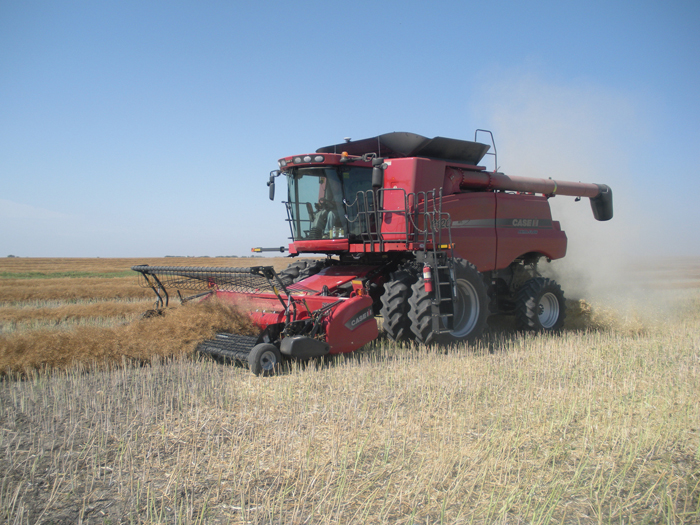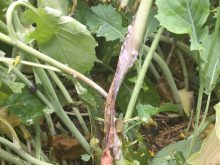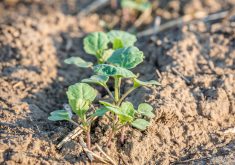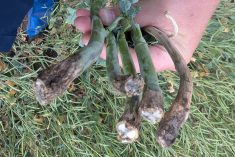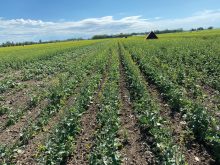Crop rotation is of utmost importance to manage residue and soil-borne diseases, and many insect species,” says Randy Kutcher, cereal and flax pathologist, University of Saskatchewan. Knowing this, it’s surprising that many growers still don’t heed rotation recommendations, especially with the potential for devastating diseases like blackleg.
Blackleg is a residue-borne disease, he explains. “Residues can be found on the lower stem and upper root pieces of previous canola crops,” he says. “And these can take a number of years to break down under prairie conditions.”
Read Also

Cancer agency reclassifies another herbicide ‘probably carcinogenic’
The WHO’s cancer research agency has now put atrazine, a herbicide well known to corn growers, in the same potential-hazard category where the agency put glyphosate.
To control blackleg, it’s necessary to reduce the amount of pathogen inoculum in the field. Rotating crops, says Kutcher, not only helps to reduce inoculum, but also exposure of any single pathogen to the same fungicide. “Without good crop rotation there is greater selection pressure on the pathogen and therefore increased risk resistant varieties become susceptible and effective fungicides become ineffective,” he says.
Why are some growers ignoring rotation recommendations? Kutcher’s guess is that economics might play a role. “Use of all possible pest control measure requires planning well in advance and for many pests, usually involves growing a number of crops,” he says. “My guess is that to be efficient in terms of time management, and perhaps bargaining power for inputs, growers have advantages when they specialize in fewer crops.”
Growing several crops does require more knowledge and experience, and sometimes equipment, which can be challenging for some producers. Regardless, Kutcher says rotation is key. “A general rule of thumb is a minimum of three unrelated crop species: a cereal, an oilseed and a pulse, so wheat-canola-pea,” he says. “Personally, I still think a four-year, four-crop rotation is desirable. When I have been involved in rotation studies of six different crops, there are usually very few plant disease issues.”
In terms of blackleg, Kutcher doesn’t think the problem is so much the pathogen itself, but more the number of acres of canola currently grown in the prairies. Short rotations coupled with limited space between fields makes for an ideal environment where the pathogen can both spread and survive.
Sexual recombination occurs in the pathogen (Leptosphaeria maculans) lifecycle, explains Kutcher, so that means increased genetic variability and increased risk of new races that can overcome resistant varieties of canola. Furthermore, it also means there’s increased potential for insensitivity to fungicides.
“The spores formed from the sexual stage are air-borne, so they can spread easily from field to field and probably many kilometres,” says Kutcher. “And the pathogen can survive a number of years on the infected canola residue; two to seven years, depending on the environment.”
Cropping system diversity
Neil Harker, weed management researcher at Agriculture and Agri-Food Canada, says that crop rotation is the basis for introducing cropping system diversity.
“Different crops allow different herbicide mode of action groups to be applied, and that is important to reduce selection intensity for herbicide resistance,” he says. “More importantly, different crops introduce other types of diversity that can disadvantage weeds and reduce herbicide resistance selection pressure.”
For example, he says, winter-annual crops, like winter wheat, fall rye and winter triticale that are seeded in the fall, rapidly cover the ground in the spring. “Those crops preclude light, nutrient and water resources from summer-annual weeds that germinate the following spring,” he says. “Therefore, many winter wheat growers do not need to apply a wild oat herbicide; reducing selection pressure for wild oat resistance to herbicides.”
On the other hand, he points out, in areas where repeated winter crops have selected for dominant winter annual weeds — think downy brome or stinkweed — the obvious solution is to grow summer-annual crops to disadvantage those weeds.
“Somewhat unfortunately,” Harker concludes, “a good weed resistance management mantra is ‘when you find something that is easy and works well, change it!’”
There are other important management strategies to incorporate on the farm, including the use of seed treatments and certified seed, as well as keeping clean fields in isolation, away from infected fields. On their own, not one management strategy is a silver bullet. For the best results, incorporate all management strategies into your system.
“Seed treatments are a good idea to control seed and soil-borne diseases, and to reduce the risk of importing new pathogen races,” says Kutcher.
Ideally, he says, seed treatments should be used to deal with specific issues, rather than as insurance. He does note, however, that it is difficult to determine if and when those problems will surface.
Choosing certified seed is another good practice for mitigating pest and disease issus. Some growers, however, think that using certified seed means that they can be more lax when it comes to rotation recommendations. Kutcher says this isn’t so.
“Certified seed means no or low contamination by pathogens, which should help get the crop off to a good start and to reduce the risk that new races of a pathogen will be introduced,” he clarifies. “But it does little to deal with the pathogen inoculum already in the field or that is incoming from neighbors fields.”
He notes that there is very little fungicide on seeds, particularly small seeds like canola. In general, he continues, seed treatment fungicides have a limited period of efficacy, some as little as two to three weeks.
Aside from practicing good rotation, isolating infected fields is also important. While isolation for blackleg control, in particular, has been shown to work in Australia, in Western Canada this could prove difficult. “In many regions,” says Kutcher, “there is so much canola that it may be difficult to put a 500 to 600 metre buffer between crops.
Even in the best of fields there’s always the potential for disease, which is why it’s recommended that growers take the time to scout. Kutcher says they should do so as often as possible, but definitely at swathing at a minimum. “For each crop species there are different things to look for and things to consider and time of scouting will vary,” he concludes. “It is a good time to identify many different diseases to record potential or existing problems and plan for the future.”


